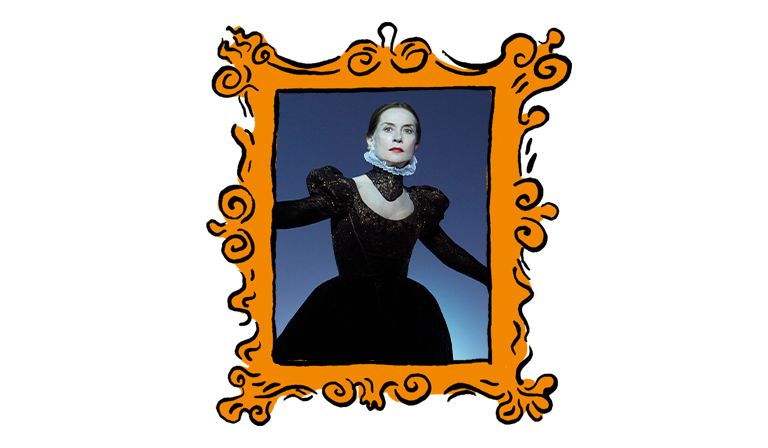Isabelle Huppert’s latest one-woman show is hard work. It is hard work for Huppert, who spends much of her performance stock-still, her body motionless except for her lips—rouge against a mask of white face paint—which contort at shutter-speed as Huppert howls out quotations from the letters of Mary, Queen of Scots. When she’s not immobile, Huppert spends the show repeating a single fragment of a 16th-century courtly dance, her voice and gestures locked together as she recites recurring phrases in both speech and mime.
It is hard work for her audience because, well, see above. This is punishing stuff, the ceaseless beat of Huppert’s routines reminiscent of Chinese water torture. For an English-speaking audience, there’s an additional problem. This is a collaboration with two Americans, the director Robert Wilson and the poet Darryl Pinckney, which has toured in development since 2019. But as befits a play about a Francophone Scottish queen—Mary was educated in France, as arranged by her French mother, Mary of Guise, in expectation of marriage to a French king—it is almost entirely in French. Pinckney’s text is translated into French by Fabrice Scott, with the English title Mary Said What She Said.
Although English surtitles were provided at last weekend’s three-day showing at the Barbican, they were poorly positioned, far out of the audience’s natural field of vision. Once in a while, a Scottish place name breaks through the fuzz of Huppert’s breathy French vocals—“Inchmahome. Peebles. Strathbogie”—sounding just as ridiculous as they must have sounded when this Frenchified woman came “home”, aged 18, to her alien realm. One of Mary’s few lasting decisions was to change her family name of “Stewart”, shared by her cousin and second husband Henry, Lord Darnley, to the French spelling, “Stuart”.
All of this should have put me off. I’m rarely inclined to sympathetic portrayals of Mary, Queen of Scots. My own academic work is on the writings of Elizabeth I, Mary’s English counterpart. As we all know, Elizabeth is the exemplar of everything a shrewd Renaissance queen could do right, while Mary got it spectacularly wrong.
The show has already split the top critics: The Times’s Clive Davis gave it one of his trademark one-star stinkers, complaining that his “brain had been pummelled into submission.” Others, including the Telegraph’s Dominic Cavendish, have raved to high heaven. All concur that the viewing experience is intense.
So why did I find myself enthralled, when not exhausted? This sort of theatre is fiercely hard work, but Mary Said What She Said often rewards that hard work. Whether you be a French or English speaker, Huppert spits out her speech at such a rapid-fire pace that you’ll never keep on top of its progression. The storyline circles around itself, jumping back and forth between episodes of Mary’s pampered, painful life. Many will find this infuriating.
But if you grasp hold of enough of the images in Pinckney’s prose poem, you’ll get a burning sense why Mary, Queen of Scots fascinated her own contemporaries, and why she fascinates many today. Unlike Elizabeth, she made all the wrong choices when it came to men. Huppert never skirts this reality. Instead, she brings fire to it.
Had she stayed in the nunnery of her childhood, this Mary considers, she might never have died on the scaffold. “But then I would never have seen a youth in all God’s perfection or known a man in all his God-given violence.” Some biopics depict Mary’s series of three husbands, all dead before their time, as an unfortunate coincidence. Huppert understands that Mary’s attraction to male violence is key to her story. How could you not expect men to kill and die on your behalf, when 10,000 Scotsmen had already died in battle for you when you were only five years old? (The Scottish army, we are reminded, rebuffed an English attempt to kidnap Mary in her childhood—Huppert is less prepared to admit Mary’s guilt in a series of plots to murder Elizabeth.)
Mary Said What She Said even manages to draw all this sex and violence out of Mary’s letters. What Wilson, Huppert and Pinckney have grasped about the scholarly study of both Mary and Elizabeth is that it depends entirely on reconstructing their correspondence. This is a big part of why, for such abstract theatre, Mary Said What She Said has a refreshingly credible understanding of Tudor history.
“A queen must sign many letters, and a woman write some of her own,” Huppert’s Mary muses. She’s right, historically. Elizabeth’s formal correspondence was produced by a mass secretariat, overseen by William Cecil. For key letters, however, we have surviving manuscripts that show Elizabeth painstakingly correcting and improving her clerks’ drafts in her own handwriting. Somewhere between all these letters, historians still argue over how to reconstruct her authentic “voice”.
But for personal correspondence, both Mary and Elizabeth developed careful codes and were terrified of their enemies attributing words to them through forgery. One of the great controversies surrounding Mary remains the question of the “Casket Letters”, a series of letters and poems that, if genuine, would attest to an affair with Darnley’s murderer, Lord Bothwell, before his death. (Mary’s supporters insisted they were fakes: nevertheless, Mary married Bothwell soon after.)
Mary Said What She Said splits its bets. We hear Mary recite one of the most controversial Casket Letters, desperately justifying her choice to marry Darnley—only for her to repeat the snatched aside, “I did not write this letter.” Moments later, she’s whispering sweet nothings to Bothwell, again in words lifted directly from these “forgeries”, and owning up entirely to their authorship. The passion, at least, is authentic. The sense of competing realities is absorbing.
This is what makes Mary Said What She Said still feel exciting: we’re never quite sure whose voice we’re hearing or whether to believe them. Even the “Mary” of the title is not who she seems. In the opening lines, we learn it refers to Mary Fleming, one of the famous “four Maries” who all shared Mary’s name and served as her ladies-in-waiting. The show buys into the myth that Mary Fleming eventually betrayed her mistress for the sake of her husband, which is poor form historically but advances the show’s interest in women who’ll do anything for a bad boy.
The question is: can you actually sit through 90 minutes of this stuff? In the online buzz around this production, much anticipated here after its tours in Europe, there has been a nasty stench of pretension, along with the insinuation that if you don’t like it, you’ve failed to understand it. For me, Mary Said What She Said rewards the hard work. If theatre like this alienates you, however, it’s fine to walk away. The entire episode is a good reminder of a core tenet of theatre criticism: if theatre fails to engage an audience, it’s never the fault of the audience.
This play is hard work...
...does that make it bad theatre?
May 16, 2024











